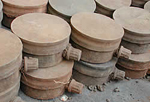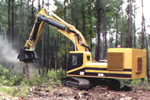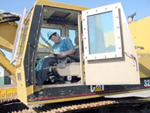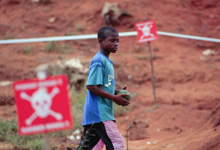Limpopo mine clearance project - final report
2001
The beginning of the year 2001 saw the continuation of left Minefield (emergency task #1). The holiday period was over on the 14th of January and after some days of re-training operations started on the 18th of January 2001.
During the short holiday period the minefield had overgrown again. The vegetation was cleared and the borders of the cleared area were marked permanently by digging trenches. QA was done by the dog team and nothing was found. The areas in the flow of the water during the floods will be burnt in order to find washed out mines once the dry season allows this later the year. Documentation and maps as handed to IND are attached to this document. The official use of the IMSMA format was only introduced in February 2001. As much as we embrace the idea of standardized documentation , as unhappy we are about the lack of foreseen data coverage for our type of operation, soil and vegetation types.
On the 29th of January demining started at emergency task #2 a couple of hundred meters away from the first task in eastern direction of dam/bridge over the Limpopo river. We breached this minefield already in 2000 to enable CFM (Mozambican Railway Company) to rebuild the tracks temporarily. As this area is now scheduled for permanent repair and workers as well as the population in general are moving in, we saw the need to widen the breach, or better said, to do a complete clearance of the area. CFM was very satisfied with our quick reaction, see attached letter of appreciation.
Between June and December, 161 Anti-Personnel mines, 42 Anti-Group mines and 2 UXO‘s were found, with a total area of 146771sqm covered, showing an increasing tendency as we went to work in what is considered the main minefield here. By the end of December, we covered a distance of 2 250 meters from the initial starting-point; however, small isolated areas within the cleared area remain uncleared because of the early onset of heavy rains. These areas were clearly marked and fenced off and will be cleared when operations commence in January 2002.
Quality control by manual means and the dog teams in this area was completed in this period; no mines or UXOs were found. The quality control team is now working as close as possible to the clearance teams, ensuring the highest possible level of safety.

Waiting for the morning train. Finally minefree the station area can be used again by the people from all over the region without any danger.
June 2002
The mine clearance operation in the Limpopo area is making better progress than ever.
The MgM-crew - supervisors, deminers, doghandlers, machine operators, mechanics and drivers- has found its rhythm. Working schedules and camplife are now familiar to everybody involved, the efforts of the last two years show real effects. People make use of their new freedom of mobility in the already minefree areas. Fields are cultivated again after years, kids can guide the cattle into the regained pastures left and right of the railway tracks without danger. Every morning crowds of people climb on the regularly stopping trains to buy and sell agricultural products on the markets of the region or even behind the frontier to nearby Simbabwe.The social impact of the MgM-operation can not be overestimated even now.
Minefields to maizefields
Before MgM arrived at Macarretane, the area was deserted and highly dangerous bush; since then, we have converted the minefields to maizefields. Areas that had been no-go areas for the past 15 years have become accessible again, allowing the local population to extend their agricultural activities into areas that they have had to avoid.

Waiting for the harvest. A former minefield adjoining the railway line, now sprouting maize
Some serious growth
This is some of the most fertile earth we have yet seen – in some areas, plants grew up a meter in a week’s time, a result of the rich sediments deposited by the floods. This amazing growth presented us with our own problems: weeds and bush impeded our work more than normal.
With MgM’s intervention, a double calamity – the minefields and the floods – was turned into prosperity for the local community; where the earth only yielded sudden death, the local farmers can now look forward to some of the best harvests of their staple food in recent memory. Like beating shields into ploughshares, we have turned minefields into maizefields.
Building blocks
By clearly marking off areas with concrete blocks inscribed with the bearing and distance to the next such marker, the local population can plant their new maizefields with the confidence that there is no hidden death awaiting them. Note the arrows pointing to top of the block and also to the lower left corner – these indicate the formerly contaminated areas.
Impromptu Gardening
Our mechanical clearing of course also aerates the ground, which increases its already incredible fertility – here, a couple of maize kernels, sown outside the rows, started sprouting on what was a pile of soil sifted by the Hydrema’s rotar.

Our paramedics help out regularly at the local clinic
Goodwill ambassadors
As with every project MgM has been involved in, developing goodwill of our mission has proven to be a crucial ingredient in our success. Foremost among the local population’s concerns are food security (minefields to maizefields), then basic health care and education.
A friend in need...
Although we are at pains not to develop parallel structures, our input into the local medical clinic has also reaped positive results. Our paramedics regularly put their medical skills to work on behalf of the local population by helping out in immunizing campaigns for babies; we also help out with medical supplies in emergencies where we can.
is a friend indeed
By inter-acting with the local community clinic and supplying them with essential information, we provide a boost to local capacity building; by having access to medical information, the local staff gains more confidence in their own work.

Empowering local people, especially women: a real peace dividend
Investing in peace
Empowering local communities is part of MgM’s mission and investment in lasting peace in Mozambique. One of the star performers in this part of our "unofficial" mission is paramedic Jorge Nhampule, seen here consulting with a local patient. By investing little more than just goodwill in this community, we will leave pillars of peace behind.
Aids Awareness
Another essential part of our social responsibility program is advocating AIDS awareness amongst our workers, who in turn hopefully spread the message into the local community. By encouraging people to act responsibly, we hope to help the community reap the harvest of peace at last.

Its enormous power and reach is supposed to increase efficiency of the difficult demining operation: the Unidisk.
October 2002
More mines at the Limpopo
This mine clearing operation turns out to be more complicated than planned. There are much more mines laid in the minebelts aside the Limpopo railroad then expected and the patterns seem to be more and more chaotic.
The operation is giving hard times to the MgM team. Since two years, the men are working now in the difficult and extensively overgrown terrain on both sides of the tracks.
It becomes obvious that the official data concerning the type and layout of the minebelts do not match the reality in many cases. Repeatedly the sappers find mines, which are not mapped at all, and the three to four rows of the belts take surprising curves.
Though these facts slow down the progress of the whole operation considerably the director of operations, Hans Georg Kruessen, does not allow himself or anybody to diminish the quality level of the work. There is only one way to get back to the operational speed of the earlier phases of the project: put in more heavy machinery to cut the dense vegetation and for the mechanical process of sifting the mine suspected soil.
Supported by the American government a so-called Unidisk is now on its way to MgMs operation in Mozambique. A modified and armored big Caterpillar excavator comes with two tools: A heavy-duty vegetation-cutting device and an extra large version of a ROTAR mine sifting drum. With its enormous boom, the machine will be able to reach into the mine infested 'unsafe' area and a simple turn of the turret brings the grabbed infested soil into a clean and 'safe' area for the sifting process. Without the time consuming transit between these two operational areas Kruessen sees a real chance to speed up the operation again -– -without any loss on the high quality level of the difficult task. The unique zero accident record of MgM is to last under all circumstances. Failure is not an option.

Chief of operation, H.G. Kruessen, gets familiar with the new machine.

Impressive proportions: the Unidisk vegetation cutter.

An explicit marking of the mine-infested surfaces saves lives.
September 2003
Real progress at Limpopo
The exuberant vegetation in the mine-infested beltts left and right of he Limpopo railway and the irregular laying patterns caused the Limpopo demining operation, which is sponsored by the German government, to proceed only sluggishly for a long time. Now the work is making good headway.
This year also the US government supports the MgM project by generously supplying heavy special machinery to clear the extremely dense vegetation. Additionally – for the field test of this prototype - the US government agreed to build a ROTAR-mine-sieving-drum especially for this machine. The Unidisk, which weighs tons, arrived by ship over the Atlantic Ocean to the east coast of Africa.
After an eventful transport (three flat tyres) of the heavy demining device from the port of the Mozambique capital Maputo to its destination in Monte Alto the Unidisk and the material container with spare parts were unloaded from the flatcar.
The new Rotar-sieving-drum, build according to MgM specifications, could be mounted without any problems. But first another tool, the hydraulic vegetation cutter, was applied.
First tasks
In an area directly opposite the Limpopo railway and not far from the main mine field the MgM team got familiar with the new device. A so-called „confidence area", meaning free from vegetation could be created in relatively short time near to the field of operations.Especially Hans Georg Kruessen, mgM director and in charge of the Limpopo operations was especially glad about the enormous strength and wide range of the UNIDISK: 24000 sqm in only 4 hours! Finally a fast way to get rid of the exuberant tropical vegetation in the mine field next to the railway station!
All of a sudden work is making good headway. Difficulties arising every once in a while when you work with new devices could be overcome with „the ship’s own means" and the help of the experienced MgM mechanics.
Mine explosion
When an anti-personnel-mine of type Gyate (approx 200 grs of TNT) exploded during the work with the UNIDISK no determinable damage resulted. The explosion happened in a area opposite a water passage inside a railway embankment which we had cleared the year before. There we found several mines which confirmed the information given to us by experts for the local mine situation. The new mines and others found by our team of manual deminers in the region now, must have been placed in the last phase of the civil war; their condition was much better than that of the mines we found in the older main mine field along the rails.
Emergency assistance in bridge construction
The high value of UNIDISK for demining Mozambique’s infrastructure was shown by several operations around large bridge building sites. Any other method than sieving through the suspicious ground with a Rotar drum would have been too dangerous. Again it was the enormous strength and range of the device which prevented a stop of the bridge building projects.
Dates, facts and figures
In three years of demining projects in Mozambique a lot has been reached. How strenuous and time-consuming humanitarian demining can be, however, will be demonstrated by a few facts and figures of the year 2002:
In spite of adverse conditions of this project MgM was able to dig many anti-personnel and anti-group mines from the ground and defuse them. 232.441,5 sqm of mine-infested land could be given back to the people of the region. But not every time the metal detector gives its typical signal, is there a mine. The MgM deminers had to carefully follow a mine suspicion 73 734 times (!) and dig out a suspicious peace of metal with the Minensuchnadel. 73034 times it was an empty cartridge shell, a piece of wire, the zip of a can of coke. 689 times it was a lethal anti-personnel mine or an anti-group mine, killing or badly hurting everything within a radius of 50 metres.
It is true: the trouble, the risks and the costs are large, but somebody has to dig out the lethal heritage of the war and render it inocuous. MgM does.





